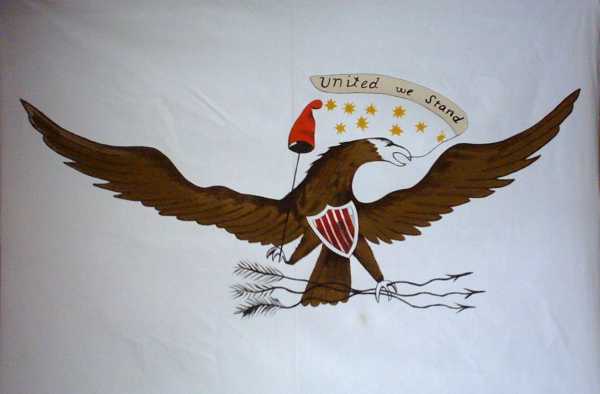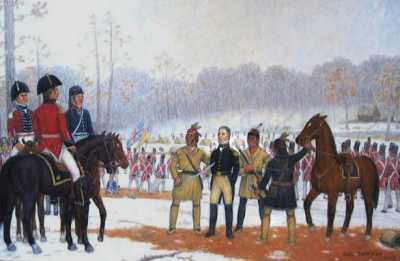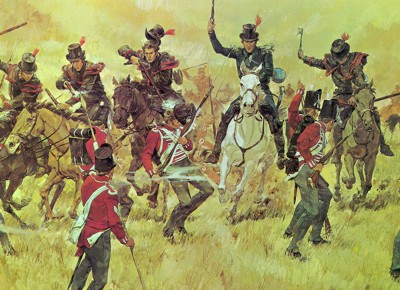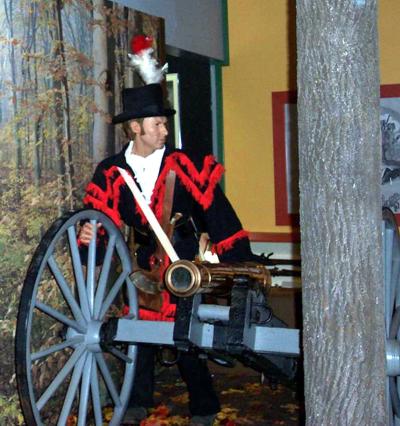
Re-Creation of Kentucky's River Raisin Battle Flag by Kevin Smith
When the War of 1812 broke out, Kentuckians formed volunteer companies even before and far in excess of that which was asked by the government. The most memorable battle of the war, as far as the Kentucky Militia was concerned, was that of the Battle of the River Raisin. This involved a detachment of 990 Kentucky militiamen who were ordered to attack Canadian troops at Frenchtown. On January 18, 1813, the Kentucky forces met the British and Indian troops who were compelled to retreat. However, unnoticed by the United States forces, 2,000 British and Indian troops reinforced existing enemy forces to overwhelm the United States regulars. Kentuckians, regardless of rank, united to bring these regulars under assault within the picket line but were unable to do so.
Not a Kentuckian who passed that picket line ever returned. The British, who were in complete control of the situation, offered terms of surrender which, were accepted. This surrender was later violated when an adequate Guard was not furnished by the British, as stipulated in the surrender, for the protection of the wounded against the drunken and frenzied Indians. As the result, all the wounded were massacred, including a great number of Kentuckians.

Painting by Hal Sherman of Englewood, Ohio depicting Winchester's surrender of the Kentucky Troops at River Raisin. The painting depicts Wyandot Chief Roundhead presenting General Winchester to Proctor.
When the news of the massacre reached Kentucky, the Legislature authorized Governor Shelby to personally take active command of reinforcements. This request from General Harrison to Governor Shelby asked for only 2,000 reinforcements, but 4,000 Kentucky volunteers were formed in Newport and immediately sent to General Harrison's aid. This was in addition to a brigade formed under the command of General Green Clay (father of Cassius M. Clay) and rushed to Fort Meigs.
Early in September of that year, Commodore Perry engaged and overcame the British Fleet, which gave Harrison command of Lake Erie and, with it, power to throw a large land force against the British then occupying Detroit. It was then that Governor Shelby, personally leading his Kentucky reinforcements, crossed Lake Erie to join the United States regulars and engage the Indian forces of Chief Tecumseh who was reinforcing the British forces.

Remember the River Raisin National Guard Heritage Print by by Ken Riley. Moraviantown, Upper Canada -- October 5, 1813 Following Commodore Perry's success at Lake Erie, a U.S. force, commanded by Gen. William Henry Harrison, engaged British troops 75 miles east of Detroit. His command included a regiment of Kentucky Mounted Riflemen led by Col. Richard M. Johnson, made up of picked militia volunteers armed with long Kentucky rifles and tomahawks. The Kentucky troops scattered the enemy army.
Under the command of "Old Tippecanoe" William Henry Harrison, a Kentucky regiment of mounted riflemen led by Colonel Richard M. Johnson marched one hundred miles to conquer General Henry A. Proctor's British Regulars at Ontario, Canada, in the Battle of Thames on October 5, 1813. William Henry Harrison, at the time territorial governor of Indiana, received his commission as a Major General of the Kentucky Militia from the Kentucky General Assembly. Richard M. Johnson is credited with killing the great Indian war chief Tecumseh during the battle, he would go on to serve as Vice-President of the United States (1837-1841) under President Martin Van Buren.
It was Governor Shelby and the Kentucky Militia's march from Kentucky to the Thames that prompted the famous Kentucky Militia pig story. This, of course, involved a pig who, in order to follow the Canadian-bound Kentucky Militia Men, walked a tremendous number of miles, swam the Ohio River, rode a ferry across Lake Erie, and endured all the hardships of Military life. After marching back with a victorious Kentucky Militia, the pig was put in the personal custody of Governor Shelby who cared for him the rest of his years.

This brass cannon was captured by General Harrison at the Battle of the Thames in 1813 and presented to Governor Isaac Shelby. Shelby presented the cannon to the State of Kentucky. Today, the cannon is on permanent display in the Kentucky Military History Museum.
The Battle of New Orleans found 2,500 Kentuckians composing one-fourth of General Andrew "Old Hickory" Jackson's army of regulars, Tennessee Militia Men, Creole Louisiana Militia, free Negroes, Lafitte's pirates and city volunteer militia. Even though Jackson's forces were outnumbered by the British, their determination and expert shooting ability, combined with the imaginative leadership of General Jackson, enabled them to handily defeat the superior British force. In 45 minutes the battle was over. Jackson forces had taken 500 British Redcoats as prisoners and killed and wounded 2,100 British as compared to 13 American dead. So ended the War of 1812 in which the Kentucky Militia had played so vital a role.
Of the approximately 24,000 Kentuckians who served during the war, 1,200 were casualties. Sixty-four percent of the Americans killed in the War of 1812 were Kentuckians.
Additional Resources